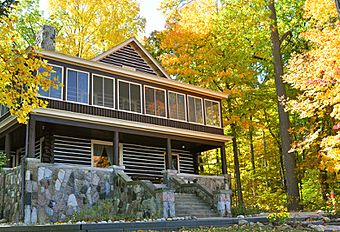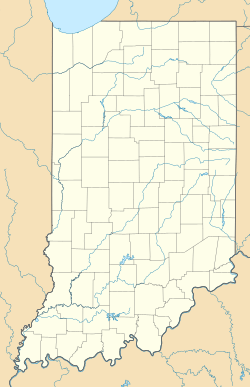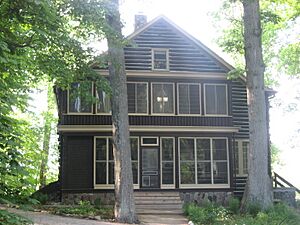Gene Stratton-Porter Cabin (Rome City, Indiana) facts for kids
Quick facts for kids |
|
|
Gene Stratton Porter Cabin
|
|

Gene's Cabin at Wildflower Woods
|
|
| Location | Southeast of Rome City off State Road 9, near corner of County Road 850 North and Pleasant Point |
|---|---|
| Nearest city | Rome City, Indiana |
| Area | 10 acres (4.0 ha) |
| Built | 1913 |
| Architect | Gene Stratton-Porter |
| Architectural style | Rustic |
| NRHP reference No. | 74000015 |
| Added to NRHP | June 27, 1974 |
The Gene Stratton-Porter Cabin is also known as the Cabin at Wildflower Woods. It was the home of Gene Stratton-Porter, a famous author, naturalist, and nature photographer from Indiana. This large, two-story cabin has fourteen rooms. It was built in 1914 and is located by Sylvan Lake, near Rome City, Indiana.
Gene Stratton-Porter lived in this cabin full-time from 1914 to 1919. After that, she moved to California. There, she kept writing books and even started a movie studio. She visited Wildflower Woods in Rome City sometimes until she passed away in 1924. The cabin was added to the National Register of Historic Places in 1974.
Stratton-Porter started her writing career in 1900. She wrote many books while living at this historic cabin. Some of her novels include Michael O'Halloran (1915) and A Daughter of the Land (1918). She also wrote Homing with the Birds (1919), which was about nature. Her children's book, Morning Face (1916), was also written here.
Contents
The Cabin's History
Why Gene Stratton-Porter Moved
In 1912, Gene Stratton-Porter decided to move. She was looking for new ideas for her writing. Her old home, the Limberlost Cabin, was in Geneva, Indiana. The Limberlost Swamp near her old home had been drained. This meant it was no longer a wild place for her to find inspiration.
She first bought a small house on Sylvan Lake, about 85 miles (137 km) from Geneva. This was a temporary place while she searched for land to build a permanent home. Stratton-Porter hoped a lakeside home would give her more privacy. It would also be a new place to watch wildlife. She had first visited Sylvan Lake in the 1880s. This was also where she met Charles D. Porter, whom she married in 1886.
Building Wildflower Woods
Gene Stratton-Porter used money from her successful books to buy wooded land overlooking the lake. Her property eventually grew to about 120 acres (49 hectares). In 1913, she helped design and build her new fourteen-room home by the lake. She called this new two-story, cedar-log cabin "Wildflower Woods." She sometimes also called it the "Limberlost Cabin" because it was similar to her first home. While helping with the cabin's construction, Stratton-Porter also wrote her book Laddie (1913).
Life at the Cabin
Stratton-Porter moved into the Wildflower Woods cabin in February 1914. She lived there full-time until 1919. Her husband, Charles, stayed at their home in Geneva. He would travel to Sylvan Lake on weekends to visit her.
Every day at Wildflower Woods, Stratton-Porter worked on her writing in the mornings. She also worked with Frank Wallace, a tree doctor. He later became Indiana's state expert on insects. Together, they turned her property into a private wildlife sanctuary. Stratton-Porter helped plant about 90 percent of the more than 14,000 trees, wildflowers, vines, and shrubs on her land. This included vegetable and flower gardens, and an orchard behind the house.
The natural setting by the lake gave her the privacy she wanted at first. However, as she became more famous, unwanted visitors and people trespassing came to her quiet woodland home.
Moving to California
Stratton-Porter had planned to live at Wildflower Woods for the rest of her life. But too many uninvited visitors eventually made her move. She moved to California in 1919. She never lived at Wildflower Woods full-time again. She still owned the property in Indiana and visited it sometimes. She passed away in California in 1924.
Many of Stratton-Porter's books were published while she lived at Wildflower Woods. Between 1914 and 1920, she published two novels: Michael O'Halloran and A Daughter of the Land (1918). She also published a nature book, Homing with the Birds (1919), and a children's book, Morning Face (1916). Her book Her Father's Daughter (1921) came out shortly after she moved to California.
In 1927, parts of a movie based on her book The Harvester (1911) were filmed at Wildflower Woods.
The Cabin Today
In 1940, the Gene Stratton-Porter Association bought Wildflower Woods. They bought it from Stratton-Porter's daughter, Jeannette Porter Meehan. In 1946, the association gave 13 acres (5.3 hectares) of the property to the State of Indiana. This included the cabin, its gardens, orchard, and a pond. Today, the Gene Stratton-Porter State Historic Site is nearly 150 acres (61 hectares). About 20 acres (8.1 hectares) of this were part of her original estate.
The Indiana State Museum and Historic Sites now takes care of and runs the Sylvan Lake property. This includes a visitor center, Stratton-Porter's cabin, and the grounds. It is open to the public from April through December. The grounds are open every day from morning until evening. You can take guided tours of the first floor of the cabin for a small fee. The site also holds special events throughout the year. It was listed on the National Register of Historic Places in 1974.
In May 1999, Gene Stratton-Porter's family brought her remains and those of her daughter, Jeannette Porter Meehan, back to Wildflower Woods. They are buried in the woods near the cabin. The author had wished to have a tree planted to mark her gravesite. She is buried near her favorite tree.
What the Cabin Looks Like
The design of the Sylvan Lake cabin was inspired by a building at the World's Columbian Exposition in Chicago. The Porters visited this fair in 1893. The Sylvan Lake cabin looks very much like Stratton-Porter's first home, the Limberlost Cabin.
The outside of the fourteen-room, two-story cabin is made of Wisconsin white cedar logs. It sits on a stone foundation. The home also has an L-shaped, two-story porch that looks out over the lake. Another two-story porch was built across the back of the house. The second-story porches had screens. This allowed them to be used as open-air sleeping rooms when the weather was warm. The property eventually included about 150 acres (61 hectares) of land. It had a formal flower garden, orchards, and a small pond.
The inside of the cabin had living spaces and work areas for Stratton-Porter's writing. The first floor includes an entrance hall, a living room, dining room, library, kitchen, a plant room, and a photographic darkroom. The entrance hall and dining room walls were covered in wild cherry-wood panels. The living room has a stone fireplace, one of three on the first floor. This fireplace has carved stone Aztec Indian heads that Mr. Porter brought from Mexico.
The second floor has seven bedrooms, one and a half bathrooms, and sleeping rooms above the porch. The home was first lit with gaslights. Electric lights were put in after Stratton-Porter moved to California in 1919.
Today, the Indiana State Museum and Historic Sites runs the cabin as a historic house museum. You can see items that belonged to Stratton-Porter, like her hand-colored pictures and her reference books. She also collected pottery, which is on display. Built-in cabinets hold her many collections. Besides the cabin, visitors can explore the formal garden. There are also wooded paths and a nearby wetlands and prairie area that are being restored. Stratton-Porter found inspiration from the woods around her home for her nature studies, writing, and photographs. Some of her furniture and other belongings are still in the cabin. They show how she liked to live her life.




